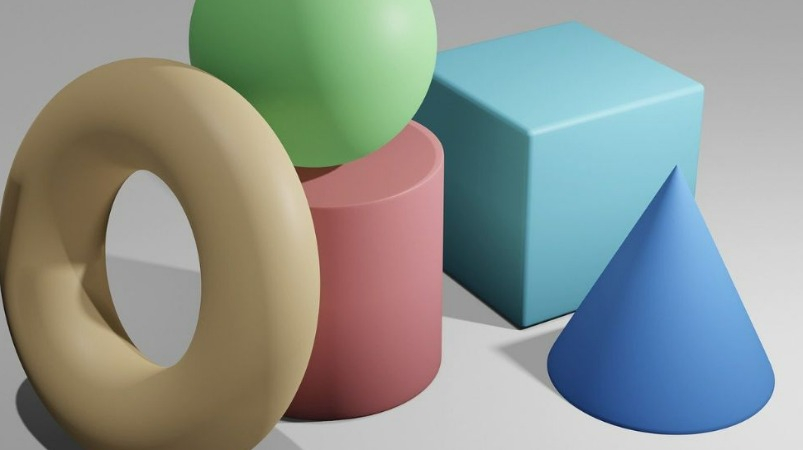Published : 05 Apr 2025 06:17 PM
Last Updated : 05 Apr 2025 06:17 PM
வெல்லுங்கள் CSAT 2025 - 17: Q and A on Volume & Surface area

Questions & Answers - (Multiple Choice) - Volume & Surface Area
கொள்குறி வினா- விடைகள் - கன அளவு & மேற்பரப்பு
1. A cubical box can hold 27 cubical small boxes. Each small cube's edge is 6cm. Find the volume of the big box.
a. 5832 cu.cm. b. 3285 cu.cm.
c. 8532 cu.cm. d. 5382 cu.cm.
2. The total surface area of a cube is numerically equal to its volume. What is the volume of that cube? (in cubic units)
a. 36 b. 64
c. 216 d. 27
3. Find the longest rod to be kept inside a cuboid of having edges 9m, 12m and 15m respectively.
a. 12 m b. 15√2 m
c. 15 m d. 17 m
4. If the height and the base area of a right circular cone are 7 cm. and 96 sq.cm. respectively, then find the volume of the cone in cubic cm.
a. 672 b. 336
c. 168 d. 224
5. Using clay, a student made a right circular cone of height 48 cm. and base radius 12 cm. Another student reshapes it in the form of a sphere. Find the radius of the sphere.
a. 24 cm. b. 12 cm.
c. 18 cm. d. 6 cm.
6. The radius of a spherical balloon increases from 3 cm.to 9 cm. as air is pumped into it. Find the ratio of volumes of the balloon in the two cases.
a. 1 : 27 b. 27 : 1
c. 1 : 9 d. 9 : 1
7. A cone, a hemisphere and a cylinder stand on equal bases and have the same height. Find the ratio of their volumes.
a. 1 : 3 : 2 b. 2 : 1 : 3
c. 1 : 2 : 3 d. 3 : 1 : 2
8. A circus tent is cylinderical to a height of 3m and conical above it. If the base radius is 10.5m and slant height of the cone is 13m, find the area of canvas required to make the tent.
a. 208 π sq.m. b. 199.5 π sq.m.
c. 188.5 π sq.m. d. 249.5 π sq.m.
9. The surface areas of two spheres are in the ratio 16 : 49. Find the ratio of their volumes.
a. 4 : 7 b. 64 : 343
c. 16 : 49 d. 33 : 65
10. The surface area of a hemisphere is 462 sq.cm. What is the volume of the hemisphere (approximately)?
a. 460 cu.cm. b. 620 cu.cm.
c. 720 cu.cm. d. 830 cu.cm.
11. A boy cut a sector containing an angle of 140° from a circle of radius 15 cm. and he folded the sector into a cone. What is the curved surface area of the cone?
a. 210 sq.cm. b. 225 sq.cm.
c. 240 sq. cm. d. 275 sq.cm.
12. If132 cu.cm. of copper is drawn into a wire 1mm in diameter, then the length of the wire in meters is
a. 168 b. 336
c. 674 d. 224
13. A boat having length 3.6m and breadth 2.5m is floating on a lake. The boat sinks by 0.8cm when a man gets on it. The mass of the man is
a. 63 kg b. 72 kg
c. 68 kg d. 78 kg
14. A metallic sheet of dimensions
24m × 18m. From each if its corners, a square is cut off such that to make an open box. If the edge of the square is 3m, the volume of the box (in cu.m) is
a. 324 b. 945
c. 648 d. 972
15. A tank of capacity 16000 litres measures externally 6.5m by 2.6m by 1.1m and its walls are 5cm. thick. The thickness of the bottom is
a. 10 cm. b. 5 cm.
c. 2.5 cm. d. 6 cm

Answers
1. a 2. c 3. b 4. d 5. b
6. a 7. c 8. b 9. b 10. c
11. d 12. a 13. b 14. c 15. a
Explanation to Answers
1. volume of each small box = 6×6×6
= 216 cu.cm.
volume of the big box
= 27×(volume of the small box)
= 27 × 216 = 5832 cu.cm.
2. Let 'a ' be the edge of the cube.
So surface area is = 6 a^2
And the volume is = a^3
Given 6 a^2 = a^3
=> a = 6
So volume of the cube is
6×6×6 = 216 cubic units.
3. If the three edges of a cuboid are
l, b and h respectively, then the length of the longest rod to be kept inside that cuboid is √(l^2 + b^2 + h^2)
So √(9^2 + 12^2 + 15^2)
= √(81+144+225) = √(450) = 15√2m
4. If the height and the base radius of a right circular cone are h and r respectively, then the volume of the cone
is (1/3)(πr^2)(h).
Given base area = πr^2 = 96 sq.cm
and h = 7cm.
So the volume of the cone
is (1/3)(πr^2)(h) = (1/3)(96)(7)
= 224cu.cm.
5. Volume of the cone
is (1/3)(πr^2)(h)
volume of the sphere
is (4/3)(πR^3)
Given r = 12 and h = 48
On equating volumes
(1/3)(π×12×12)×(48) = (4/3)(πR^3)
=> 4R^3 = 12×12×48
=> R^3 = 12^3
=> R = 12cm.
6. Volumes are in the ratio
a^3 : b^3 if the radii are in the ratio
a : b
Given a : b = 3 : 9 = 1 : 3
Volumes are in the ratio
1^3 : 3^3 = 1 : 27
7. Hemisphere's radius and height are the same.
So cone has radius 'r' and height is also
'r'. Similarly the cylinder has radius 'r' and height is also 'r'.
The ratio of Volumes of a cone, a hemisphere and a cylinder stand on equal bases and have the same height is
(1/3)π(r^2)(r) : (2/3)π(r^3) : π(r^2)((r)
=> 1/3 : 2/3 : 1
=> 1 : 2 : 3
8. Curved surface area of cylinder is
2πrh where r is base radius and h is the height. Here r = 10.5m h = 3m
Latent surface area of the cone is
π r l where r is base radius and l is the slant height. r = 10.5m l = 13m
Here both the cylinder and the cone have the same base radius.
Canvass needed
2π(10.5)(3) + π(10.5)(13)
= 63π + 136.5π = 199.5π sq.m.
9. If radii of two spheres are in the ratio
a : b, then the ratio of surface areas and volumes are respectively
a^2 : b^2 and a^3 : b^3.
Given a^2 : b^2 = 16 : 49
=> a : b = 4 : 7
=> a^3 : b^3 = 4^3 : 7^3
= 64 : 343
10. Surface area of a hemisphere
= 3π(r^2)
Equating 3π(r^2) = 462
=> 3 ×(22/7)(r^2) = 462
=> (r^2) = 7×7 => r = 7 cm
The volume of the hemisphere
= (2/3)π(r^3) = (2/3)×(22/7)×7×7×7
= (44×49)/(3) = (2156)/(3)
= 718.67 cu.cm.
Approximately 720cu.cm.
11. Base circumference of the cone = length of the arc of 140° from a circle of radius 15 cm. If ' r ' is the base radius of the cone then
(140/360) × 2 × π × 15 = 2π × r
=> r = (7/18)×15 = 35/6
Here r = 35/6cm and the slant height of the cone l = 15cm.
The curved surface area of the cone
= π r l = (22/7)×(35/6)×15
= (22×35×15)/(7×6) = 11×25
= 275 sq.cm.
12. Diameter 1mm -> radius (1/20)cm.
Let the length of the wire be 'l'
Volume of copper wire
= (22/7)×(1/20)×(1/20)× l
Here (22/7)×(1/20)×(1/20)× l = 132
=> l = 6×7×20×20 cm
=> l = 168m.
13. Here 0.8cm = 0.008m
Vilume of water displaced
= (3.6×2.5×0.008) cu.m.
= 0.072 cu.m.
Density of water = 1000kg/cu.m.
So Mass of the man
= volume displaced × density
= (0.072)×1000 kg.
= 72 kg.
14. Clearly l = 24 - 6 = 18m
b = 18 - 6 = 12m and h = 3m.
Volume of the box = l b h
= 18×12×3 = 648 cu.m.
15. Let the thickness of the bottom
be 't' cm
So
{(650 - 10)(260 - 10)(110 - t)} = 16000×1000
=> 640×250×(110 - t) = 16000×1000
=> 110 - t = (16000×1000)/(640×250)
=> 110 - t = 100 => t = 10cm.
- கட்டுரையாளர், போட்டித் தேர்வு பயிற்சியாளர், குளோபல் விக்கிமாஸ்டர்; தொடர்புக்கு: success.gg@gmail.com
முந்தைய அத்தியாயம் > வெல்லுங்கள் CSAT 2025 - 16: Q and A on Perimeter & Area
FOLLOW US
தவறவிடாதீர்!
- SDAT: முதன்மை நிலை விளையாட்டு மையங்களில் சேர விண்ணப்பிப்பது எப்படி?
- “வக்பு திருத்த மசோதாவை நிறைவேற்றியது தேசிய ஒருமைப்பாட்டுக்கு எதிரானது” - திருமாவளவன்
- ட்ரம்ப்பின் புதிய வரிகளால் உலகளாவிய மந்தநிலைக்கு 60% வாய்ப்பு: ஜே.பி.மோர்கன் எச்சரிக்கை
- பஞ்சாப் அணியின் சாம்பியன் கனவும் கேப்டன் ஸ்ரேயாஸ் ஐயரும் - IPL 2025
Sign up to receive our newsletter in your inbox every day!


WRITE A COMMENT
Be the first person to comment